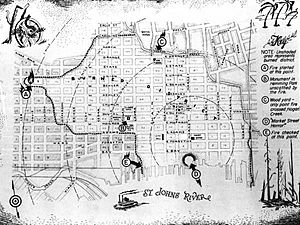Great Fire of 1901 facts for kids

Map of the Great Fire of 1901 that destroyed Downtown Jacksonville
|
|
| Date | May 3, 1901 |
|---|---|
| Location | Jacksonville, Florida |
| Outcome | 2,368 structures destroyed 7 killed |
The Great Fire of 1901 was a huge fire that happened in Jacksonville, Florida, on May 3, 1901. It was one of the worst disasters in Florida's history. It was also the third largest city fire in the United States, after the Great Chicago Fire and the 1906 San Francisco fire.
Contents
The Great Fire
How the Fire Started
In 1901, Jacksonville had many buildings made of wood. Most roofs were also made of wood shingles. The city had been very dry for a long time. This made the wooden buildings easy to catch fire.
Around noon on Friday, May 3, 1901, workers at the Cleaveland Fibre Factory left for lunch. This factory was on Beaver and Davis Streets. A few minutes later, sparks from a nearby chimney started a fire. The fire began in a pile of Spanish moss that was drying.
Factory workers tried to put out the fire with buckets of water. They had done this many times before for small fires. But this time, the fire quickly grew too big. A strong wind from the east helped the flames spread fast. The fire moved from house to house very quickly.
In just eight hours, the fire burned 146 city blocks. It destroyed more than 2,368 buildings. Nearly 10,000 people lost their homes. People said they could see the glow from the fire in Savannah, Georgia. The smoke plumes could be seen as far away as Raleigh, North Carolina.
James Weldon Johnson, who was a school principal in Jacksonville, later shared his thoughts. He felt that firefighters focused on saving certain areas. This meant that other parts of the city, especially where many African American families lived, suffered more damage from the fire.
What Happened After
Florida Governor William S. Jennings quickly declared martial law in Jacksonville. This meant the military took control to help. Several state militia units were sent to help the city.
Rebuilding started right away. The city was returned to regular government control on May 17. Seven people were reported to have died in the fire.
St. Andrew's Episcopal Church was built of bricks in 1887. It was the only major church in the city to survive the fire. The Duval County Courthouse and all its important property records were destroyed. Because of this, property records in Duval County today often refer to "the current public records" or "the former public records" if they are from before the fire.
Rebuilding Jacksonville
An architect from New York City, Henry John Klutho, played a big part in rebuilding the city. He and other architects liked a style called "Prairie Style" architecture. This style was popular in cities like Chicago. They designed many new buildings in Jacksonville with this style, adding a Florida touch.
Some of the buildings Klutho designed include the Dyal–Upchurch Building (1902) and the Carnegie Library (1905). He also designed the Bisbee Building (1909) and the Morocco Temple (1910).
Many of Klutho's buildings were torn down over time. However, some of his creations are still standing. His most famous work is the St. James Building. Today, the Jacksonville City Hall uses the St. James Building. Jacksonville has one of the largest collections of Prairie Style buildings outside the Midwest.
Images for kids




